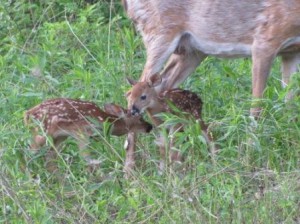According to a fascinating and ongoing whitetail project conducted by researchers at Penn State, discretion and secrecy are top priorities to a doe about to give birth in May or June. Does split up and avoid contact with other does of their social group.
A young doe that will give birth for the first time will seek out a secluded fawning site outside of her core area. An older doe will usually return to the same fawning spot each year to give birth. Most yearling does generally give birth to a single fawn. Twins are common among adult does.
The researchers point out that in Pennsylvania where this project is happening, 80% of pregnant yearling does have single fawns; 74% of does 3 years old or older produce twins; and only 3% of adult does have triplets.
Labor lasts 12 or more hours. If disturbed by man or a predator, a doe is known to be able to stop the labor process.
At birth, a doe licks the fawn(s) dry and establishes a bond that will let her distinguish her fawns from all the other fawns in a group. Establishing this bond takes few hours and is critical. Without it, a doe may abandon her fawn(s).
A doe nurses her newborn(s) shortly after birth and remains with or close by for the first 24 hours.
Research has shown that fawns of experienced does (4 years old or older) have lower mortality rates than those of younger does. Older does are more dominant and can stake out better areas for fawn rearing.
Here are some more fawn facts.
I am fascinated with the entire deer rut and breeding process, all way to the birth of fawns in spring. There is no more beautiful creature on God’s Earth than a whitetail fawn, just look at the pictures.







You’re right about that: “There is no more beautiful creature on God’s Earth than a whitetail fawn…”
Wife and I saw a doe with her new little one in the headlights on the way home Sat. night. Wife was impressed that the little guy was already up and mobile, etc. She missed it the first time so I turned around and drove back to the site. Sure enough mom and little dude were still there. Got me some “Aww!” points with the Mrs. as well. Speaking of “little guys” our daughter, Hadleigh Sue, will be 1 year old on June 7th. Growing like a weed.